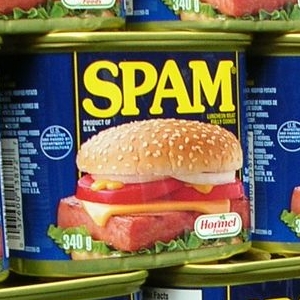SPAM always looked like an unlikely candidate for fame status. But circumstances made it a legend during times of upheaval. Now, we’re in the midst of economic and climate crises, and a war in Europe. And SPAM is coming to the fore once again…
 SPAM Teriyaki Kabobs: A new menu idea from the Hormel Foods test kitchens…
SPAM Teriyaki Kabobs: A new menu idea from the Hormel Foods test kitchens…
SPAM first appeared on store shelves in 1937, and cost (US)$0.25 per 12 oz. can. It was a simple concoction of pork shoulder, chopped ham, water, sugar and sodium, and remains so today.
So how did it become such a spectacular hit? And how did it spread around the world in a mere decade?
A familiar story
We’ve told the basic SPAM story before in this space. It’s an epic tale of war and peace, need and plenty, universal appeal and widespread criticism. And folks still love to argue about the details. Truly the stuff of legends.
Aiming to create a long-shelf-life canned meat product, father George and son Jay Hormel, meat packers in Austin, came up with SPAM. There are many stories about how it got its name, but a recent story in CNN Business says, “They offered a $100 prize for the best name. […] It needed to be short for display purposes and to fit on one-column newspaper advertisements. It also had to pronounceable in any language.” SPAM was suggested by a guest at a party which Jay Hormel attended. It was simply an acronym for ‘Spiced Ham’. But it stuck.
On the road (to war)
More than 100 million pounds of SPAM was shipped overseas as field rations for U.S. soldiers during the Second World War. That’s how it was introduced to the Pacific islands (particularly Hawaii), Japan and Southeast Asia so quickly. Korea and the Asian mainland followed a few years later when SPAM again went to war with American troops in the Korean conflict.
Asians loved it because a.) it was a pork product, friendly to their traditional diets, b.) it was salty and a little spicy, like many of their traditional foods,l c.) it was readily available, and d.) it was cheap. SPAM is now considered a staple in Hawaii where unique ‘national’ recipes have been developed featuring it.
Also given to British and Commonwealth troops and civilians as a wartime aid food, it had invaded most of the world by 1950.
Post-war progress
After the wars, Hormel realized SPAM was a household name and the company started to promote it heavily. It was positioned as an inexpensive, all-purpose meat on which any family cook could base breakfasts, lunches or suppers.
SPAM remained a high-profile brand, appearing allover the homemakers’ magazines and TV commercials for decades to come. Until nutritionists began to take a closer look at it, and started to caution consumers about its high fat and salt content. That was in the late 1980s and 1990s. Into the early 21st century, SPAM’s reputation slipped into a place where it was generally viewed as a cheap, unhealthy, pseudo-food, suitable only for people of the lower classes.
Another go-round
But in the 20-teens, SPAM’s fortunes apparently changed again. The CNN story says new generations of young chefs and diners have embraced it as a fun, palate-pleasing ingredient that’s getting play in all kinds of new dishes, many riding innovation-forward menus at the highest levels.
“When I first started getting into the brand, we started to notice this transition to a stronger multicultural set of consumers,” said Brian Lillis, SPAM’s brand manager for six years, told CNN. “[Young chefs, especially from Asian backgrounds have] brought with them the traditions of utilizing the product in their home country or where maybe their ancestors came from.”
Dishes such as Spam Fried Rice, Spam Musabi, Yakitori, and Poke are appearing on high-end resto menus with increasing regularity. And Hormel is once again highlighting SPAM’s versatility in dishes on social media and in TV advertisements.
What goes around…
~ Maggie J.

